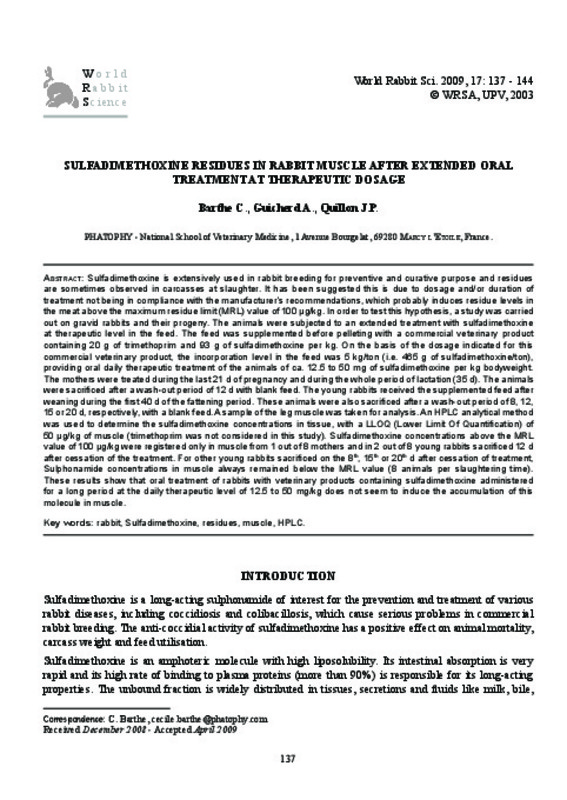JavaScript is disabled for your browser. Some features of this site may not work without it.
Buscar en RiuNet
Listar
Mi cuenta
Estadísticas
Ayuda RiuNet
Admin. UPV
Sulfadimethoxine residues in rabbit muscle after extended oral treatment at therapeutic dosage
Mostrar el registro sencillo del ítem
Ficheros en el ítem
| dc.contributor.author | Barthe, C.
|
|
| dc.contributor.author | Guicherd, A.
|
|
| dc.contributor.author | Quillon, J.P.
|
|
| dc.date.accessioned | 2009-10-02T11:43:03Z | |
| dc.date.available | 2009-10-02T11:43:03Z | |
| dc.date.issued | 2009 | |
| dc.identifier.issn | 1257-5011 | |
| dc.identifier.uri | http://hdl.handle.net/10251/6264 | |
| dc.description.abstract | [EN] Sulfadimethoxine is extensively used in rabbit breeding for preventive and curative purpose and residues are sometimes observed in carcasses at slaughter. It has been suggested this is due to dosage and/or duration of treatment not being in compliance with the manufacturer's recommendations, which probably induces residue levels in the meat above the maximum residue limit (MRL) value of 100 ¿g/kg. In order to test this hypothesis, a study was carried out on gravid rabbits and their progeny. The animals were subjected to an extended treatment with sulfadimethoxine at therapeutic level in the feed. The feed was supplemented before pelleting with a commercial veterinary product containing 20 g of trimethoprim and 93 g of sulfadimethoxine per kg. On the basis of the dosage indicated for this commercial veterinary product, the incorporation level in the feed was 5 kg/ton (i.e. 465 g of sulfadimethoxine/ton), providing oral daily therapeutic treatment of the animals of ca. 12.5 to 50 mg of sulfadimethoxine per kg bodyweight. The mothers were treated during the last 21 d of pregnancy and during the whole period of lactation (35 d). The animals were sacrificed after a wash-out period of 12 d with blank feed. The young rabbits received the supplemented feed after weaning during the first 40 d of the fattening period. These animals were also sacrifi ced after a wash-out period of 8, 12, 15 or 20 d, respectively, with a blank feed. A sample of the leg muscle was taken for analysis. An HPLC analytical method was used to determine the sulfadimethoxine concentrations in tissue, with a LLOQ (Lower Limit Of Quantification) of 50 ¿g/kg of muscle (trimethoprim was not considered in this study). Sulfadimethoxine concentrations above the MRL value of 100 ¿g/kg were registered only in muscle from 1 out of 8 mothers and in 2 out of 8 young rabbits sacrificed 12 d after cessation of the treatment. For other young rabbits sacrificed on the 8th, 15th or 20th d after cessation of treatment, Sulphonamide concentrations in muscle always remained below the MRL value (8 animals per slaughtering time). These results show that oral treatment of rabbits with veterinary products containing sulfadimethoxine administered for a long period at the daily therapeutic level of 12.5 to 50 mg/kg does not seem to induce the accumulation of this molecule in muscle. | en_EN |
| dc.language | Inglés | en_EN |
| dc.publisher | World Rabbit Science. ICTA. UPV | en_EN |
| dc.relation.ispartof | World Rabbit Science | |
| dc.rights | Reserva de todos los derechos | es_ES |
| dc.subject | Hplc | en_EN |
| dc.subject | Muscle | en_EN |
| dc.subject | Residues | en_EN |
| dc.subject | Sulfadimethoxine | en_EN |
| dc.subject | Rabbit | en_EN |
| dc.title | Sulfadimethoxine residues in rabbit muscle after extended oral treatment at therapeutic dosage | en_EN |
| dc.type | Artículo | en_EN |
| dc.identifier.doi | 10.4995/wrs.2009.653 | es_ES |
| dc.rights.accessRights | Abierto | es_ES |
| dc.description.bibliographicCitation | Barthe, C.; Guicherd, A.; Quillon, J. (2009). Sulfadimethoxine residues in rabbit muscle after extended oral treatment at therapeutic dosage. World Rabbit Science. 17(3):137-144. https://doi.org/10.4995/wrs.2009.653 | es_ES |
| dc.relation.publisherversion | https://doi.org/10.4995/wrs.2009.653 | es_ES |
| dc.description.upvformatpinicio | 137 | |
| dc.description.upvformatpfin | 144 | |
| dc.description.volume | 17 | |
| dc.description.issue | 3 | |
| dc.identifier.eissn | 1989-8886 | es_ES |








